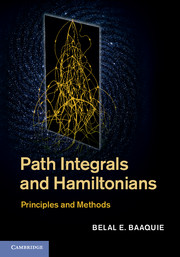Book contents
- Frontmatter
- Dedication
- Contents
- Preface
- Acknowledgements
- 1 Synopsis
- Part one Fundamental principles
- Part two Stochastic processes
- Part three discrete degrees of freedom
- 8 Ising model
- 9 Ising model: magnetic field
- 10 Fermions
- Part four Quadratic path integrals
- Part five Action with acceleration
- Part six Nonlinear path integrals
- References
- Index
10 - Fermions
from Part three - discrete degrees of freedom
Published online by Cambridge University Press: 05 April 2014
- Frontmatter
- Dedication
- Contents
- Preface
- Acknowledgements
- 1 Synopsis
- Part one Fundamental principles
- Part two Stochastic processes
- Part three discrete degrees of freedom
- 8 Ising model
- 9 Ising model: magnetic field
- 10 Fermions
- Part four Quadratic path integrals
- Part five Action with acceleration
- Part six Nonlinear path integrals
- References
- Index
Summary
The degrees of freedom studied so far have been either real or complex variables. These variables commute under multiplication, in the sense that two numbers a, b satisfy ab = ba; commuting variables are generically called bosonic variables, or bosonic degrees of freedom. Typical of the bosonic case are the degrees of freedom for a collection of quantum mechanical particles.
Interactions of fundamental particles are generally mediated by bosonic fields such as the Maxwell electromagnetic field, whereas mass is usually carried by particles that are fermions, the most familiar being the electron.
Two key features distinguish fermions from bosons:
Fermions obey the Pauli exclusion principle, which states that no two fermions can occupy the same quantum state. This is the reason the concept of intensity does not apply to a fermion. A high intensity electric field is a reflection of the presence of a large number of photons, which are bosons, in the same quantum state; for photons, any number of photons can be in the same quantum state. In contrast, an electron is either in a quantum state or it is not; in particular, ignoring spin, an electron exists at a point or there is no electron there.
The state function of a multi-bosonic system is totally symmetric in that the exchange of any two bosonic degrees of freedom yields the same state function. In contrast, a multi-fermion system is totally anti-symmetric: the exchange of any two fermion degrees of freedom gives the same state – but with a negative sign.
- Type
- Chapter
- Information
- Path Integrals and HamiltoniansPrinciples and Methods, pp. 198 - 222Publisher: Cambridge University PressPrint publication year: 2014



